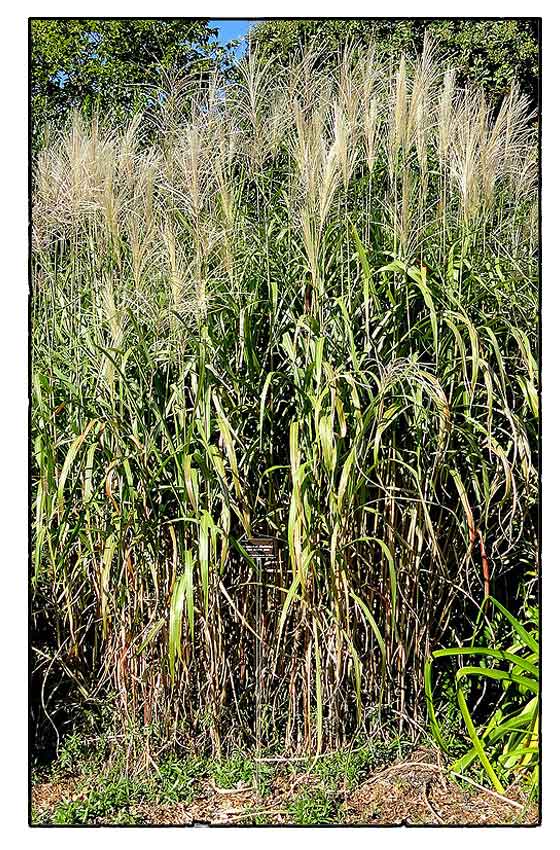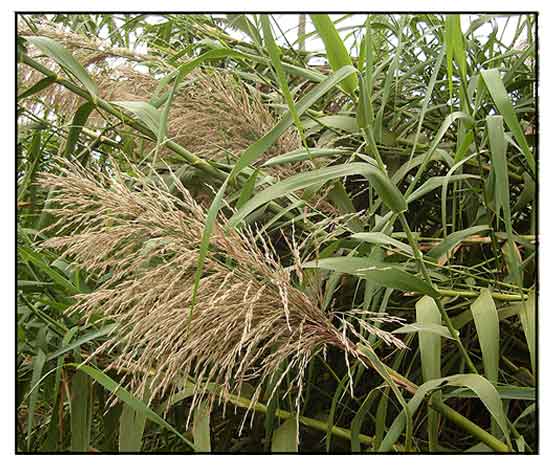 Gen info Gen info
- Miscanthus, or silvergrass, is a genus of African, Eurasian, and Pacific Island plants in the grass family, Poaceae, containing about 20 species.
- Micanthus species reported in the Philippines are Micanthus floridulus, M. sinensis, and M. depauperatus. Micanthus floridulus and M. sinensis share similar folkloric medicinal and craft uses.
- Miscanthuns floridulus, the Pacific Island silvergrass, is a species of perennial grass in the family Poaceae.
- Etymology: the genus name Miscanthus derives from Greek word miskos meaning a 'stem', and anthos meaning 'flower' referring to the stalked spikelets. The specific epithet floridulus derives from Latin floridus meaning 'flowery or blooming'.
Botany
Miscanthus floridulus is a robust, tufted, erect, perennial grass, 1.5-3 m tall. Culm terete, filled with pith, glabrous, pruinose below the nodes. Leaf-sheath glabrous or outer margin with long hairs; ligule 1-2 mm tall; blade 60-150 cm × 1-4.5 cm, base attenuate, margins very rough, apex acute, long hairy above the base or only just behind the ligule, otherwise glabrous and smooth with wide midrib. Inflorescence 30-45 cm long; branches numerous, erect or nodding, lower ones 20-40 cm long, solitary or 2-6 together, often from near base already with 3-10 long, lateral branches; spikelets not crowded; pedicels slender, thickened upwards, those of a pair 2-4 mm and 4-9 mm long respectively, both, or at least the longer one, ultimately rather divergent or recurved; spikelet about 4 mm long; basal hairs 5-11 mm long, white or purple; lower glume 3-5-nerved, upper glume 3-nerved; lower lemma 2.2-4.2 mm long, finely ciliate in upper half, 0-1-nerved; upper lemma 2-3.5 mm long, 3-nerved, awn twisted, 6-11 mm long; palea 1.5-2.7 mm long; stamens 3; stigmas exserted near middle of spikelet. (1)
Distribution
- Native to the Philippines.
- Also native to China, Cook Is., Fiji, Hainan, Japan, Jawa, Laos, Malaya, Maluku, Myanmar, Nansei-shoto, New Guinea, Samoa, Sulawesi, Sumatera, Taiwan, Vietnam, etc.
(3)
 Constituents Constituents
- The ultimate fibers of Miscanthus have an average length of 1.4-1.5 mm, a lumen width of 7 µm, and a cell wall thickness of 6 µm. Straw contains 38-48% α-cellulose, 26-34% hemicelluloses, 18-24% lignin, and 2-6% ash. The α-cellulose and lignin levels decrease from base to top of stem, the opposite of hemicelluloses and ash. In a UK study, chemical Miscanthus pulps were superior in yield (42-52%), tensile strength and tear strength compared to wheat straw, but inferior in brightness. Energy content of Miscanthus is about 16-19 MJ/kg dry matter. (1)
- Lignin and cellulose contents of M. floridulus stems were 22.33 ± 2.21% and 43.13 ± 2.7%, respectively.
(see study below) (10)
Properties
- Studies have suggest antidiabetic, phytoremediative properties.
Parts used
Leaves, aerial parts.
Uses
Edibility
- In East Kalimantan, shoots are eaten as vegetable. (1)
Folkloric
- In the Philippines, decoction of Miscanthus shoots used for treatment of cough. In Indo-China, juice or decoction used on bites from wild animals. (1)
- In Ifugao, Luzon, the Kalanguya tribe apply crushed leaves
on wounds and cuts. Higher efficacy noted when mixed with crushed leaves leaves of Annatil (Deutzia sp, Saxifragaceae). (6)
- In Sablan, the Ibalois
chew fresh leaves or drink decoction of leaves of sapsap (M. floridulus) for treatment of ulcer and diarrhea. (8)
- In Fiji, used for the treatment of type-2 diabetes.
Others
- Crafts / Construction: Stems and used for thatching, making house walls, floor coverings, baskets, toys, and souvenir items. Also used for fences, 'balag' for climbing of vegetables, and drying racks for tobacco. In Luzon, split stems used to make screens and window shades. In the Moluccas and Papua New Guinea, stems are made into arrow shafts. (1) Matured stems used to make fences and for outer walls of traditional houses.
- Paper: Used for paper making.
- Fuel / Light: Stems used as fuel in the Philippines and Indo-China. (1) Dried stems made into torches and burned to provide light when walking in the dark. Torch is 1-2 m long, which burns slowly.
- Fodder: In the Philippines, leaves used as fodder for water buffaloes. Although sometimes used as fodder, it is not suitable because of harshness -- the scabrid-toothed margins of leaves can make severe cuts. (1)
- Industrial potential: In Europe, Miscanthus is being investigated as a renewable source of energy and potential source of fiber for composite materials like MDF (medium density fiberboard) and chipboard, pulp for paper and packaging, biodegradable geotextiles, fibers and sorbents, and insulation. (1)
Studies
• Antidiabetic / Inhibition of α-Glucosidase: Study evaluated five Fijian medicinal plants for total phenolic content (TPC), α-amylase and α-glucosidase activity. The hydromethanolic extract of Miscanthus floridulus significantly inhibited α-glucosidase activity with IC50 of 1.58 ± 0.03 ng/µl compared to acarbose IC50 of 3,34 ± 0.15 ng/µl. Results showed potential source of natural inhibitors of enzymes involved in carbohydrate metabolism and potential use in treatment of T2DM. (4)
• Phytoremediation / Lead-Contaminated Land: Phytoremediation is an eco-friendly technology for restoring contaminated agricultural land. Study evaluated the potential of using M. floridulus in the phytoremediation of fallow land contaminated by 6,000 mg/kg of lead that have accumulated primarily in the roots of M. floridulus. After one year, the average lead contents in roots and shoots were 806.7 and 50.3 mg/kg, respectively. Results suggest M. floridulus is effective for phytostabilization of lead-contaminated soil and is a lead-tolerant plant. The M. floridulus grown on contaminated fields can be used as biofuel, each hectare of dry matter with potential to generate 365.1 GJ of thermal energy per year, equivalent to heat energy from combustion of 13.4 tons of hard coal. (5)
• Oil Absorption / Gold Nanoparticles / Leaves: Study evaluated the use of M. floridulus leaves to absorb oil. Oil absorption ability of leaves was approximately 3.59 and 3.91 (g oil/g leaves) for soybean and motor oil, respectively. Results showed M. floridulus leaves have hydrophobic structure on the leaf surface. (7)
• Oil Absorption / Gold Nanoparticles / Stems: Except for leaves, stems count for a major portion of M. floridulus biomass. In this study, the lignin and cellulose contents of M. floridulus stems were 22.33 ± 2.21% and 43.13 ± 2.7%, respectively. Gold NPs were used to investigate the absorption ability of M. floridulus stems. Oil absorption quality by amount of soybean and motor oils absorbed by one gram of pulverized stems was estimated at 2.25 ± 0..25 and 2.33 ± 0.18 g, respectively. (10)
Availability
Wild-crafted. |

![]()




 Constituents
Constituents